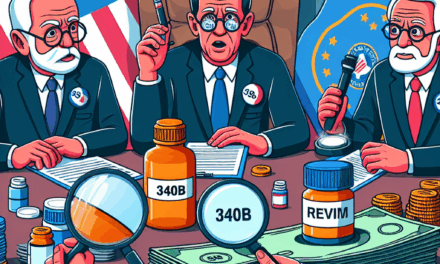CVS to Leave ACA Individual Exchanges and Partners with Novo Nordisk for Wegovy
The healthcare landscape in the United States is constantly evolving, with major players like CVS Health making significant strategic decisions that impact millions of Americans. Recently, CVS announced its decision to exit the Affordable Care Act (ACA) individual exchanges while simultaneously forming a partnership with Novo Nordisk to promote Wegovy, a medication for weight management. This article delves into the implications of these developments, exploring the reasons behind CVS’s exit from the ACA exchanges, the partnership with Novo Nordisk, and the broader context of healthcare in America.
1. Understanding CVS Health’s Decision to Exit ACA Individual Exchanges
CVS Health’s decision to leave the ACA individual exchanges marks a significant shift in its business strategy. The ACA exchanges were designed to provide affordable health insurance options to individuals and families who do not have access to employer-sponsored insurance. However, CVS’s exit raises questions about the sustainability of these exchanges and the future of healthcare accessibility in the U.S.
1.1 The Financial Landscape of ACA Exchanges
One of the primary reasons for CVS’s exit from the ACA exchanges is the financial challenges associated with participating in these markets. Insurers have faced mounting losses due to high medical costs and a risk pool that often skews towards individuals with greater healthcare needs. According to a report from the Kaiser Family Foundation, many insurers have struggled to maintain profitability in the ACA marketplace, leading to a wave of exits from the exchanges.
- High medical costs: The cost of providing care for individuals with chronic conditions has increased significantly.
- Risk pool challenges: The ACA exchanges often attract a higher proportion of sick individuals, leading to increased claims.
- Regulatory pressures: Insurers face stringent regulations that can complicate their ability to operate profitably.
CVS’s decision reflects a broader trend among insurers who are reevaluating their participation in the ACA exchanges. The company has cited the need to focus on more sustainable business models that align with its long-term goals.
1.2 Impact on Consumers
The exit of CVS from the ACA exchanges could have significant implications for consumers. With fewer options available, individuals seeking coverage may face higher premiums and reduced access to care. This is particularly concerning for low-income individuals who rely on these exchanges for affordable health insurance.
- Increased premiums: With fewer insurers in the market, competition decreases, potentially leading to higher costs for consumers.
- Limited choices: Consumers may have fewer plans to choose from, limiting their ability to find coverage that meets their needs.
- Access to care: The exit of a major player like CVS could disrupt care continuity for individuals who rely on their services.
As CVS exits the ACA exchanges, it is crucial for policymakers to consider measures that can stabilize the marketplace and ensure that consumers continue to have access to affordable healthcare options.
1.3 Strategic Refocus on Core Services
CVS’s decision to leave the ACA exchanges also reflects a strategic refocus on its core services. The company has been investing heavily in its pharmacy and healthcare services, including its MinuteClinic and telehealth offerings. By exiting the ACA exchanges, CVS can allocate resources towards enhancing these services, which are more aligned with its long-term vision.
- Investment in pharmacy services: CVS is focusing on expanding its pharmacy offerings, including specialty medications and personalized care.
- Enhancing telehealth: The company is investing in telehealth services to meet the growing demand for virtual care.
- Integrating healthcare services: CVS aims to create a more integrated healthcare experience for its customers, combining pharmacy, clinic, and telehealth services.
This strategic shift may position CVS for greater success in a rapidly changing healthcare environment, where consumers are increasingly seeking convenient and accessible care options.
2. The Partnership with Novo Nordisk for Wegovy
In a move that underscores its commitment to addressing obesity and related health issues, CVS has partnered with Novo Nordisk to promote Wegovy, a medication approved for chronic weight management. This partnership represents a significant step in CVS’s efforts to expand its offerings in the weight management space.
2.1 Understanding Wegovy and Its Role in Weight Management
Wegovy (semaglutide) is a glucagon-like peptide-1 (GLP-1) receptor agonist that has been shown to help individuals achieve significant weight loss when combined with a reduced-calorie diet and increased physical activity. Clinical trials have demonstrated that Wegovy can lead to an average weight loss of 15% or more in individuals with obesity.
- Mechanism of action: Wegovy works by mimicking a hormone that regulates appetite, leading to reduced hunger and increased feelings of fullness.
- Clinical efficacy: Studies have shown that Wegovy is effective in promoting weight loss and improving metabolic health.
- Long-term benefits: Beyond weight loss, Wegovy has been associated with improvements in conditions such as type 2 diabetes and hypertension.
The partnership with Novo Nordisk allows CVS to offer Wegovy as part of its comprehensive healthcare services, providing patients with access to effective weight management solutions.
2.2 Implications for CVS’s Business Model
The collaboration with Novo Nordisk aligns with CVS’s broader strategy to enhance its healthcare offerings and address the growing obesity epidemic in the U.S. By incorporating Wegovy into its services, CVS can position itself as a leader in weight management and chronic disease prevention.
- Diversification of services: The partnership allows CVS to diversify its offerings beyond traditional pharmacy services.
- Enhanced patient engagement: By providing access to effective weight management solutions, CVS can improve patient engagement and outcomes.
- Potential for increased revenue: The growing demand for weight management solutions presents an opportunity for CVS to generate additional revenue streams.
This strategic partnership not only benefits CVS but also addresses a critical public health issue, as obesity rates continue to rise in the U.S. and around the world.
2.3 Addressing the Obesity Epidemic
The partnership with Novo Nordisk comes at a time when obesity is recognized as a major public health crisis. According to the Centers for Disease Control and Prevention (CDC), the prevalence of obesity in the U.S. was 42.4% in 2017-2018, a significant increase from previous years. This trend has serious implications for healthcare costs and overall population health.
- Healthcare costs: Obesity-related conditions, such as diabetes and heart disease, contribute to rising healthcare costs, estimated to be over $147 billion annually.
- Impact on quality of life: Individuals with obesity often face stigma and discrimination, leading to negative impacts on mental health and overall well-being.
- Need for comprehensive solutions: Addressing obesity requires a multifaceted approach, including medication, lifestyle changes, and access to healthcare services.
By partnering with Novo Nordisk, CVS is taking a proactive approach to combat obesity and improve health outcomes for its patients. This partnership aligns with the company’s mission to help people on their path to better health.
3. The Broader Context of Healthcare in America
The decisions made by CVS Health are reflective of broader trends in the American healthcare system. As the landscape continues to evolve, several key factors are shaping the future of healthcare delivery and access.
3.1 The Shift Towards Value-Based Care
One of the most significant trends in healthcare is the shift towards value-based care, which emphasizes quality of care over the volume of services provided. This model incentivizes healthcare providers to focus on patient outcomes and cost-effectiveness.
- Improved patient outcomes: Value-based care aims to enhance the quality of care delivered to patients, leading to better health outcomes.
- Cost containment: By focusing on preventive care and chronic disease management, value-based care can help reduce overall healthcare costs.
- Increased accountability: Providers are held accountable for the quality of care they deliver, encouraging them to prioritize patient needs.
CVS’s partnership with Novo Nordisk aligns with this trend, as it focuses on providing effective solutions for chronic conditions like obesity, ultimately improving patient health and reducing costs associated with obesity-related diseases.
3.2 The Role of Technology in Healthcare
Technology is playing an increasingly important role in healthcare delivery, with innovations such as telehealth, electronic health records, and data analytics transforming the way care is provided. CVS has been at the forefront of adopting technology to enhance its services.
- Telehealth expansion: The COVID-19 pandemic accelerated the adoption of telehealth, allowing patients to access care remotely.
- Data-driven decision-making: Healthcare organizations are leveraging data analytics to improve patient care and operational efficiency.
- Patient engagement tools: Technology is enabling healthcare providers to engage patients more effectively, promoting adherence to treatment plans.
By integrating technology into its services, CVS can enhance patient experiences and improve health outcomes, further solidifying its position as a leader in the healthcare industry.
3.3 The Importance of Preventive Care
Preventive care is essential for reducing the burden of chronic diseases and improving population health. As healthcare costs continue to rise, there is a growing emphasis on preventive measures that can help individuals maintain their health and avoid costly interventions.
- Screening and early intervention: Preventive care includes regular screenings and early interventions that can detect health issues before they become severe.
- Health education: Educating patients about healthy lifestyle choices is crucial for preventing chronic diseases.
- Access to preventive services: Ensuring that individuals have access to preventive services is essential for improving overall health outcomes.
CVS’s focus on weight management through its partnership with Novo Nordisk is a prime example of how preventive care can be integrated into healthcare services, ultimately benefiting patients and the healthcare system as a whole.
4. The Future of CVS Health and Its Impact on the Healthcare Landscape
As CVS Health navigates its exit from the ACA exchanges and its partnership with Novo Nordisk, the company’s future will be shaped by several key factors that will influence its role in the healthcare landscape.
4.1 Adapting to Regulatory Changes
The healthcare industry is subject to constant regulatory changes that can impact how companies operate. CVS must remain agile and adaptable to navigate these changes effectively.
- Policy shifts: Changes in healthcare policy at the federal and state levels can affect reimbursement rates and coverage options.
- Compliance requirements: CVS must ensure compliance with regulations related to patient privacy, billing, and quality of care.
- Advocacy efforts: Engaging in advocacy efforts can help CVS influence policy changes that align with its business goals.
By staying informed and proactive, CVS can position itself to thrive in a dynamic regulatory environment.
4.2 Expanding Access to Care
Access to care remains a critical issue in the U.S., particularly for underserved populations. CVS has an opportunity to expand its reach and improve access to healthcare services.
- Community-based initiatives: CVS can develop programs that target underserved communities, providing access to essential healthcare services.
- Partnerships with local organizations: Collaborating with community organizations can enhance CVS’s ability to address health disparities.
- Telehealth services: Expanding telehealth offerings can improve access for individuals who may face barriers to in-person care.
By prioritizing access to care, CVS can play a vital role in addressing healthcare disparities and improving health outcomes for all individuals.
4.3 Fostering Innovation in Healthcare Delivery
Innovation will be key to CVS’s success as it adapts to the changing healthcare landscape. The company must continue to explore new ways to deliver care and enhance patient experiences.
- Investing in research and development: CVS can invest in research to identify new treatment options and improve existing services.
- Leveraging technology: Embracing technological advancements can streamline operations and enhance patient engagement.
- Exploring new business models: CVS can explore innovative business models that align with the evolving needs of consumers.
By fostering a culture of innovation, CVS can remain competitive and continue to meet the needs of its patients effectively.
5. Conclusion: Key Takeaways
The decision by CVS Health to exit the ACA individual exchanges and partner with Novo Nordisk for Wegovy represents a pivotal moment in the company’s evolution. As CVS navigates these changes, several key takeaways emerge:
- Financial sustainability is a critical concern for insurers participating in the ACA exchanges, leading to strategic exits.
- The partnership with Novo Nordisk positions CVS as a leader in weight management, addressing a significant public health issue.
- The broader healthcare landscape is shifting towards value-based care, technology integration, and preventive measures.
- CVS has opportunities to expand access to care and foster innovation in healthcare delivery.
- Staying adaptable to regulatory changes will be essential for CVS’s long-term success.
As CVS Health continues to evolve, its decisions will have far-reaching implications for consumers, the healthcare industry, and public health. By focusing on sustainable business practices and innovative solutions, CVS can play a vital role in shaping the future of healthcare in America.





